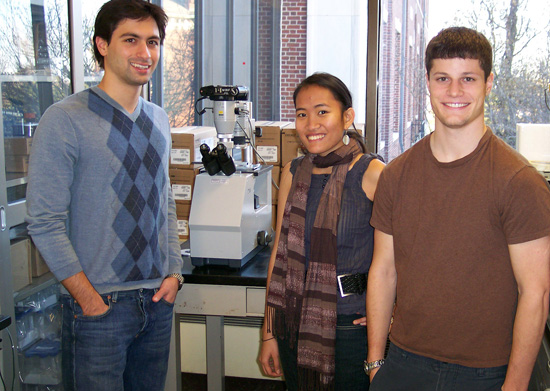Students Receive Fellowships to Continue Research on Seizures, Genetics
 |
| Matthew Donne ’07, Jenna Gopilan ’07 and Dan Austin ’08 received fellowships based on academic achievement and enthusiasm for laboratory science. |
| Posted 12/20/06 |
| Three Wesleyan students received research bioscience fellowships from the Connecticut Business & Industry Association (CBIA) and the Connecticut United for Research Excellence (CURE). The fellowships are designed to increase the number of qualified scientists interested in pursuing careers in the biosciences.
Molecular biology and biochemistry major Dan Austin ’08; neuroscience and behavior major Jenna Gopilan ’07; and biology major Matthew Donne ’07 each received the $5,000 fellowship. The students were selected on the basis of academic achievement, enthusiasm for laboratory science and interest in pursuing a career in the pharmaceutical, biotechnology, or biomedical manufacturing industry. Austin and Gopilan work under the direction of Jan Naegele, chair of the Biology Department, professor of biology and professor of neuroscience and behavior. Donne works under the direction of Laura Grabel, the Fisk Professor of Natural Science and professor of biology. Austin, of Williston, Vt., will examine how a brain-specific enzyme called STEP, influences “It is our hypothesis that the presence or absence of certain proteins dictates which cells survive in the brain,” Austin says. “We hope that this project may contribute to determining a new therapeutic approach to treat epilepsy.” Gopilan, of Los Angeles, Calif., also aims to understand seizures. With the CURE grant, she will continue her research on “The Role of Serotonin in Adult Neurogenesis in the Hippocampus of Wildtype and DNA Repair Deficient Mice. Gopilan will use an epilepsy model in mice to study how neural stem cells respond to damage caused by epileptic seizures. Previous work in the Naegele laboratory showed that seizures produce a strong increase in the production of new neurons in the adult brain, from populations of neural stem cells located in the hippocampus. The mice she studies lack a DNA repair protein that may be critical for maintaining neural stem cell populations in the brain. This research study will help her understand how DNA repair, serotonin and seizures interact to regulate stem cells. Gopilan will extract neural stem cells from the hippocampus after seizures and grow them in tissue culture to define serotonin’s effect on the birth and growth of hippocampal neurons. “This project will be beneficial in recognizing the different factors involved in repairing the brains of patients with temporal lobe epilepsy,” Gopilan explains. Donne, of Litchfield, Conn., hopes to use his fellowship to characterize the extraembryonic cell types present in human embryonic stem cell embryoid bodies and to generate outgrowth cultures on different extracellular matrix substrates that reflect in vivo conditions. To determine the cell types present, Donne will be using immunohistochemistry and specific cell type markers. Such research in the future can be applied to determining the specific genetic basis for miscarriages and other early fetal or placenta relationships, Donne says. Austin, Gopilan and Donne are three of 10 students from Wesleyan, the University of Connecticut and the University of New Haven, to receive the fellowships. Results of their research will be presented at StemCONN 07, Connecticuts Stem Cell Research International Symposium, to be held at the State Capitol on March 27, 2007. The fellowship program is made possible through a U.S. Department of Labor H-1B grant being administered by CBIA. The CBIA is Connecticuts largest business organization with 10,000 members. CURE is a statewide coalition of over 100 educational and research institutions, biotechnology and pharmaceutical companies and other supporting businesses. Both organizations are dedicated to promoting the growth of research and science in Connecticut. “This fellowship program helps Connecticut continue to have the highly educated workforce needed to remain competitive in bioscience, while keeping the brightest students in the state,” says Judith Resnick, CBIA director of workforce development and training, and the deputy director of the association’s Education Foundation. |
| By Olivia Drake, The Wesleyan Connection editor |

